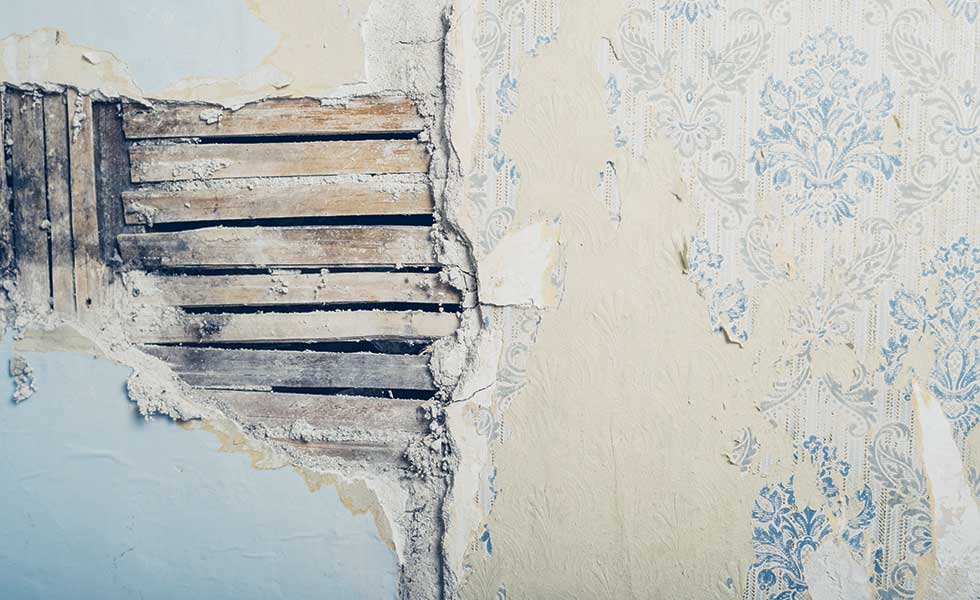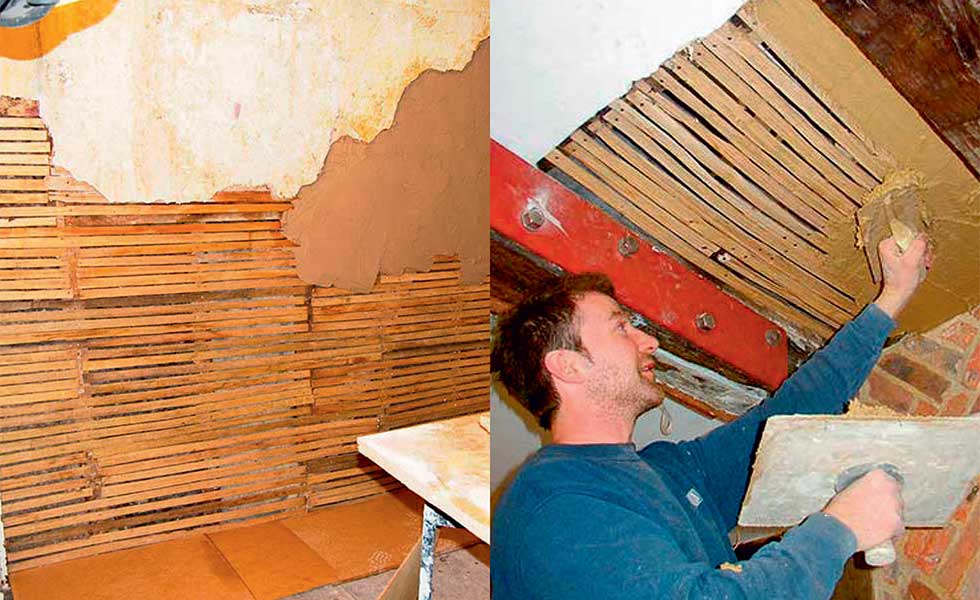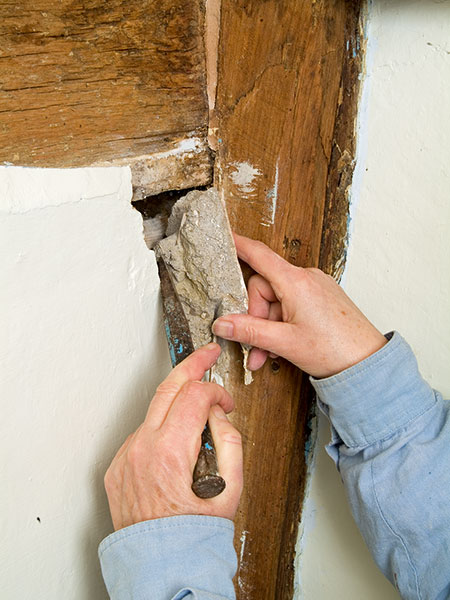Plaster repair: how to fix cracks, bulges, loose plaster and damp
Plaster repairs are an occasional requirement if you own an old home. These old plastered walls bring so much character to a period home, but to keep them in good condition it’s essential to be on the look out for early signs of damage

Plaster repair is usually within the capabilities of a competent DIYer. So if you are renovating an old home, spotting the signs and knowing the remedies is essential. And if you find that the damage needs repair beyond your skills, it is still important to know what is required.
Original plaster finishes on internal walls and ceilings are worth treating with care. Unlike the smooth, lifeless and hard cementitious and gypsum plasters common today, old plasters tend to have a textural undulating quality, offer flexibility and, most important of all, allow the wall to breathe, enabling moisture to disperse. Therefore, maintaining these qualities is a very important part of a well-managed house renovation.
Fortunately plasterwork is easily repaired but, although plastering may look easy, it’s a highly skilled job so it’s always best to call in a plasterer with experience of old buildings. To find the most appropriate materials for the job, seek advice from specialist suppliers.
Plaster deterioration warning signs
Being able to spot the signs of damage is a must-have skill for anyone who lives in an old home. Early detection means the problem is easier to fix before it gets too bad.
Plaster is likely to be damaged by movement or the results of external factors like impact or damp. Over time, plaster may delaminate or become detached from the surface beneath.
In the case of stud walls and ceilings, timber laths are fixed between the studs or joists and the plaster is pushed through the gaps between the laths. Rotten laths can result in plaster sagging or bowing.
- DIY: Make plastering walls an easy job with our guide.
What to look for:
- Inappropriate modern plasters and finishes
- Cracks and bulges
- Loose plaster
- Plaster that sounds hollow when tapped
- Sagging ceilings
- Underlying structural problems
- Damp patches and staining
Repairing cracks and bulges in plaster
Some cracks and bulges in plaster may be superficial or localised; others result from failure of the masonry or timber beneath, or may indicate wider structural problems within the building.
Action:
- Rake out thin cracks and fill with a good filler.
- Investigate bulges or anything larger than a hairline crack.
- Monitor cracks over a period of time by marking and dating their end point on the wall.
- Consult a structural engineer if in any doubt.
- Make necessary repairs with appropriate traditional materials.
- Cracks and pockmarks may be filled using matching plaster, or narrow ones with proprietary interior filler gauged with whiting.
- To patch repair plasterwork, slightly treat the exposed edges of the existing plaster with water or diluted PVA (one part to 10 of water) to control suction and prevent cracking. Alternatively, gypsum may sometimes be added to a lime plaster mix for the same purpose.

Major repairs underway to a lath and plaster wall; plastering laths on the ceiling is usually fairly straightforward
Reattaching loose plaster
Where an area of plaster has become detached from masonry it can sound hollow when tapped. If it has lost its key to laths, it may feel springy. In both cases the plaster might remain intact as haired lime plaster is generally strong and acts as a sheet, even if areas have parted company with the wall itself.
Conservators use specialist methods to reattach loose plaster or delaminating layers, especially where of historic value, so if in doubt bring in an expert.
Action:
- Test plaster by tapping and prodding.
- Attempt to secure the plaster using stainless-steel screws and large washers.
- Cut away defective plaster and investigate.
- Where laths have failed, cut back to studs or joists and replace.
- Use like-for-like materials to repair any damage.
- Plaster that matches the existing material is preferable where repairs will be limewashed.

Removing a loose section of old lime plaster
Mending sagging or cracked ceilings
Problems with ceilings frequently result from the plaster bond having failed, structural movement, failure of joists, damp problems and rotten or beetle-infested laths.
Action:
- Investigate from above if access is available from a loft or by carefully lifting floorboards.
- Resolve structural issues to joists.
- Always use screws for any fixings to avoid vibrations to fragile ceilings.
- Where the bond with laths has failed, reinforce by pouring fresh plaster from above and strengthening with a jute scrim set into this and secured to the joists.
Stripping plaster surfaces
Wallpapers, paints and other finishes can spoil the appearance of plaster surfaces and may trap moisture. When removing, proceed with care and be aware that wallpaper may be acting as a support to defective plaster underneath.
Action:
- Always undertake a test first on a small unobtrusive area.
- Gently use a scraper but avoid scoring through the surface into the plaster.
- Apply warm water or proprietary wallpaper stripper with a sponge or brush.
- Use a steam stripper to remove stubborn coatings, being careful not to allow steam to penetrate the plaster.
Treating damp and staining
Unlike modern plasters, lime plasters that have become wet generally dry out with their integrity intact so need not be removed.
Where damp is present, salts may pose a problem. If these continue to come to the surface, plaster may have to be stripped.
Soot staining from flues can often be seen on the surface above a fireplace.
Action:
- Always treat the cause of any damp problems, not the symptoms.
- Ensure the wall has been allowed to dry out fully before applying plaster.
- Where staining appears through a chimney breast it may be necessary to replaster.
- If you decide to replaster stained areas, when the problem is not severe it is sometimes suggested to use a slurry of cow dung painted on to the masonry before applying new lime plaster.
- If staining continues to persist, consider ‘dry lining’ by fixing battens to the wall and applying laths and lime plaster.
Traditional plaster coats
Often referred to as a ‘scratch’ coat, the first plaster coat creates a reasonably flat surface and is ‘scratched’ in a diamond pattern to provide a key for the next coat.
For good-quality work, a ‘floating coat’ or a ‘straightening coat’ is applied next and is worked until perfectly level. This in turn is scratched and then a thin ‘setting’ or ‘skimming coat’ is used to create a smooth surface.
Repairing decorative plasterwork
Where decorative plasterwork, such as cornicing, is damaged repairs can usually be undertaken by a skilled plasterer.
Early plasterwork was ‘run’ in situ using a template and running it around the top of the wall over wet plaster to create the profile of the cornice.
Later details were formed using fibrous plasterwork. These incorporated a hessian scrim that strengthened the back and were formed in flexible moulds.
Plasterwork detail is often obscured under paint layers but take great care when attempting to strip these areas.
Warm water, steam, chemical removers, poultice systems and proprietary wallpaper stripper may all be successful in removing paint from plasterwork but always undertake a test first on a small unobtrusive area.
A toothbrush and a sharpened stick are useful tools, but be careful to avoid any accidental digging with scrapers.
Additional words by Douglas Kent and Marianne Suhr
Join our newsletter
Get small space home decor ideas, celeb inspiration, DIY tips and more, straight to your inbox!
-
 This colourful home makeover has space for kitchen discos
This colourful home makeover has space for kitchen discosWhile the front of Leila and Joe's home features dark and moody chill-out spaces, the rest is light and bright and made for socialising
By Karen Wilson Published
-
 How to paint a door and refresh your home instantly
How to paint a door and refresh your home instantlyPainting doors is easy with our expert advice. This is how to get professional results on front and internal doors.
By Claire Douglas Published
-
 DIY transforms 1930s house into dream home
DIY transforms 1930s house into dream homeWith several renovations behind them, Mary and Paul had creative expertise to draw on when it came to transforming their 1930s house
By Alison Jones Published
-
 12 easy ways to add curb appeal on a budget with DIY
12 easy ways to add curb appeal on a budget with DIYYou can give your home curb appeal at low cost. These are the DIY ways to boost its style
By Lucy Searle Published
-
 How to smooth walls without plastering, according to design experts
How to smooth walls without plastering, according to design expertsTry these ways to smooth walls without plastering — the best ways to prep your walls without needing a skim coat
By Anna K. Cottrell Last updated
-
 5 invaluable design learnings from a festive Edwardian house renovation
5 invaluable design learnings from a festive Edwardian house renovationIf you're renovating a period property, here are 5 design tips we've picked up from this festive Edwardian renovation
By Ellen Finch Published
-
 Real home: Glazed side extension creates the perfect garden link
Real home: Glazed side extension creates the perfect garden linkLouise Potter and husband Sean's extension has transformed their Victorian house, now a showcase for their collection of art, vintage finds and Scandinavian pieces
By Laurie Davidson Published
-
 I tried this genius wallpaper hack, and it was perfect for my commitment issues
I tried this genius wallpaper hack, and it was perfect for my commitment issuesBeware: once you try this wallpaper hack, you'll never look back.
By Brittany Romano Published